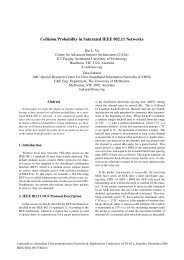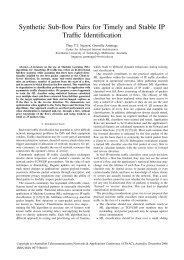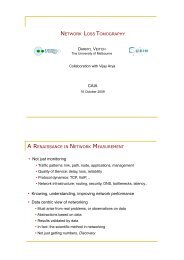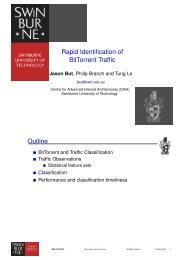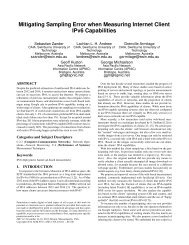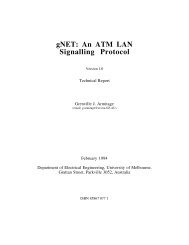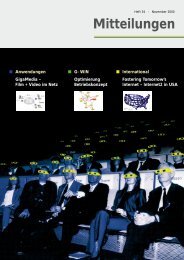Chapter 3 Time-to-live Covert Channels - CAIA
Chapter 3 Time-to-live Covert Channels - CAIA
Chapter 3 Time-to-live Covert Channels - CAIA
You also want an ePaper? Increase the reach of your titles
YUMPU automatically turns print PDFs into web optimized ePapers that Google loves.
0<br />
1<br />
1-p L<br />
1-p L<br />
p L<br />
p L<br />
CHAPTER 3. TIME-TO-LIVE COVERT CHANNELS<br />
0<br />
?/_<br />
1<br />
p R<br />
p R<br />
1-p R<br />
1-p R<br />
p N<br />
p N<br />
1-p N<br />
1-p N<br />
Packet loss Packet<br />
reordering<br />
TTL Noise<br />
Figure 3.10: TTL channel model<br />
We model the overall channel as a cascade of the three separate channels where the<br />
leftmost channel is either a deletion channel with a symbol lost indicated by a “_” or an<br />
erasure channel with an unknown symbol value indicated by a “?” (see Figure 3.10).<br />
In the remainder of the section we derive the capacity of the overall channel. The<br />
capacity of the BSC is [22]:<br />
0<br />
1<br />
C = 1 − H (p) = 1 + p · log 2 (p) + (1 − p) · log 2 (1 − p) , (3.5)<br />
where H(.) is the binary entropy. The two cascaded BSCs with error probabilities pR<br />
and pN can be replaced by a single BSC with error probability:<br />
pRN = pR (1 − pN) + pN (1 − pR) . (3.6)<br />
The exact capacity of (cascaded) deletion channels is not known, but various lower<br />
and upper bounds exist [171, 172, 173, 20, 174]. Diggavi and Grossglauser proved a<br />
lower bound of the capacity of a combined deletion/substitution channel depending on<br />
the probabilities for deletions pd and substitutions pe [175]:<br />
C ≥ max {︀ 0,1 − [︀ H (pd) + (1 − pd) H (pe) ]︀}︀ . (3.7)<br />
This bound is tighter than the more general lower bounds for the capacity of dele-<br />
tion/insertion/substitution channels given by Gallager and Zigangirov [171, 172, 173].<br />
This means in any case the lower bound of the capacity of the TTL covert channel is:<br />
C ≥ max {︀ 0,1 − [︀ H (pL) + (1 − pL) H (pR (1 − pN) + pN (1 − pR)) ]︀}︀ . (3.8)<br />
If the overt traffic has sequence numbers we model packet loss as erasures. Depending<br />
on the probability of erasures ε and substitutions pe the cascade of erasure and BSC<br />
channel has a channel capacity of [176]:<br />
C = (1 − ε)(1 − H (pe)) . (3.9)<br />
50<br />
0<br />
1



